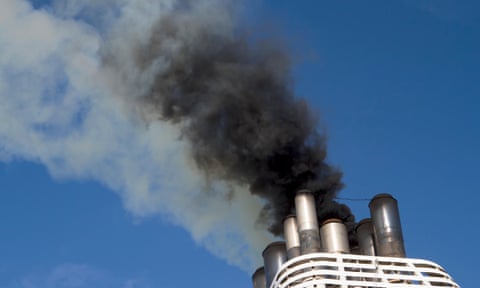Damian Carrington Environment editor
Prof James Hansen says pace of global heating has been significantly underestimated, though other scientists disagree
 |
The analysis concluded that recent cuts in sun-blocking shipping pollution have raised temperatures more than thought. Photograph: scphoto/Alamy
|
The pace of global heating has been significantly underestimated, according to renowned climate scientist Prof James Hansen, who said the international 2C target is “dead”.
A new analysis by Hansen and colleagues concludes that both the impact of
recent cuts in sun-blocking shipping pollution, which has raised
temperatures, and the sensitivity of the climate to increasing fossil
fuels emissions are greater than thought.
The group’s results are at the high end of estimates from mainstream
climate science but cannot be ruled out, independent experts said.
If
correct, they mean even worse extreme weather will come sooner and there
is a greater risk of passing global tipping points, such as the
collapse of the critical Atlantic ocean currents.
Hansen, at Columbia University in the US, sounded the alarm to the general public about climate breakdown in testimony he gave to a UN congressional committee in 1988.
“The
Intergovernmental Panel on Climate Change (IPPC) defined a scenario
which gives a 50% chance to keep warming under 2C – that scenario is now
impossible,” he said. “The 2C target is dead, because the global energy
use is rising, and it will continue to rise.”
The new analysis said global heating is likely to reach 2C by 2045, unless solar geoengineering is deployed.
The
world’s nations pledged in Paris in 2015 to keep global temperature
rise below 2C above preindustrial levels and to pursue efforts to limit
it to 1.5C. The climate crisis has already supercharged extreme weather across the world with just 1.3C of heating on average in recent years destroying lives and livelihoods – 2C would be far worse.
Prof
Jeffrey Sachs, also at Columbia University, said: “A shocking rise of
warming has been exposed by, ironically, a reduction of pollutants, but
we now have a new baseline and trajectory for where we are.”
Climate scientist Dr Zeke Hausfather,
who was not part of the study, said it was a useful contribution. “It’s
important to emphasise that both of these issues – [pollution cuts] and
climate sensitivity – are areas of deep scientific uncertainty,” he
said.
“While Hansen et al are on the high end
of available estimates, we cannot say with any confidence that they are
wrong, rather that they just represent something closer to a worst-case
outcome.”
In the new study, published in the journal Environment: Science and Policy for Sustainable Development,
Hansen’s team said: “Failure to be realistic in climate assessment and
failure to call out the fecklessness of current policies to stem global
warming is not helpful to young people.”
They
said the IPCC analysis was heavily reliant on computer models and that
the complementary approach they took of making more use of observations
and climate analogues from the distant past was needed.
The world has seen extraordinary temperatures over the last two years. The primary cause is the relentless rise in CO2 emissions from the burning of fossil fuels. The peak of the El Niño climate cycle in 2024 added an extra temperature boost.
However,
these two factors do not fully explain the extreme temperatures, or
their persistence after the El Niño ended in mid-2024. This left puzzled climate scientists
asking if there was a worrying new factor not previously accounted for,
or if the extra heat was an unusual but temporary natural variation.
A
key focus has been on emissions from shipping. For decades, the
sulphate particles produced by ships burning fuel have blocked some
sunlight from reaching the Earth’s surface, suppressing temperatures.
But in 2020, new anti-pollution regulations came into force, sharply cutting the level of the aerosol particles. This led to more heat from the sun reaching the surface, which scientists measure as watts per square metre (W/m2).
Hansen’s
team’s estimate of the impact of this – 0.5W/m2 – is significantly
higher than five other recent studies, which ranged from 0.07 to 0.15
W/m2, but would explain the anomalous heat. Hansen’s team used a
top-down approach, looking at the change in the reflectivity over key
parts of the ocean and ascribing that to the reductions in shipping
emissions. The other studies used bottom-up approaches to estimate the
increase in heat.
“Both approaches are useful
and often complementary,” said Dr Gavin Schmidt, director of Nasa’s
Goddard Institute for Space Studies. “But I think in this case, Hansen’s
approach is too simple and doesn’t factor in changes in Chinese
emissions, or internal variability.”
The new
study also argues that the planet’s climate sensitivity to rising carbon
emissions has been underestimated, partly because of the
underestimation of the impact of reduced shipping emissions.
Climate sensitivity is defined by scientists as the temperature rise that would result from a doubling of CO2
levels in the atmosphere. Again, Hansen’s team have used a different
method to most scientists and come up with a higher estimate.
The
IPCC, a collaboration of the world’s climate scientists, found that the
computer models that best reproduce past temperatures have a climate
sensitivity of 2.5C to 4C.
Hansen’s team took a simpler approach, calculating the potential range in temperature rises for a doubling of CO2
and then using data on how much heat the Earth has trapped to estimate
the most likely climate sensitivity. Their estimate is 4.5C. Cloud formation, which is affected by global heating and aerosol pollution, is a key source of the uncertainties.
Anomalously high temperatures have continued in January 2025,
which set a new record for the month and confounded expectations that
temperatures would drop with the current La Niña, the cooler part of the
El Niño cycle. “This unexpected record may presage higher temperatures
this year than many of us thought,” said Hausfather.
Hansen’s group also argues that the accelerated global heating they predict will increase ice melting in the Arctic.
“As
a result, shutdown of the Atlantic Meridional Overturning Circulation
(Amoc) is likely within the next 20-30 years, unless actions are taken
to reduce global warming – in contradiction to conclusions of IPCC.
“If
Amoc is allowed to shut down, it will lock in major problems including
sea level rise of several metres – thus, we describe Amoc shutdown as
the ‘point of no return’.”
The central estimate of another recent study on the timing of an Amoc collapse was 2050.
However,
Hansen said the point of no return could be avoided, based on the
growing conviction of young people that they should follow the science.
He called for a carbon fee and dividend policy, where all fossil fuels
are taxed and the revenue returned to the public.
“The
basic problem is that the waste products of fossil fuels are still
dumped in the air free of charge,” he said. He also backed the rapid
development of nuclear power.
Hansen also
supported research on cooling the Earth using controversial
geoengineering techniques to block sunlight, which he prefers to call
“purposeful global cooling”.
He said: “We do
not recommend implementing climate interventions, but we suggest that
young people not be prohibited from having knowledge of the potential
and limitations of purposeful global cooling in their toolbox.”
Political
change is needed to achieve all these measures, Hansen said: “Special
interests have assumed far too much power in our political systems. In
democratic countries the power should be with the voter, not with the
people who have the money. That requires fixing some of our democracies,
including the US.”
Links



